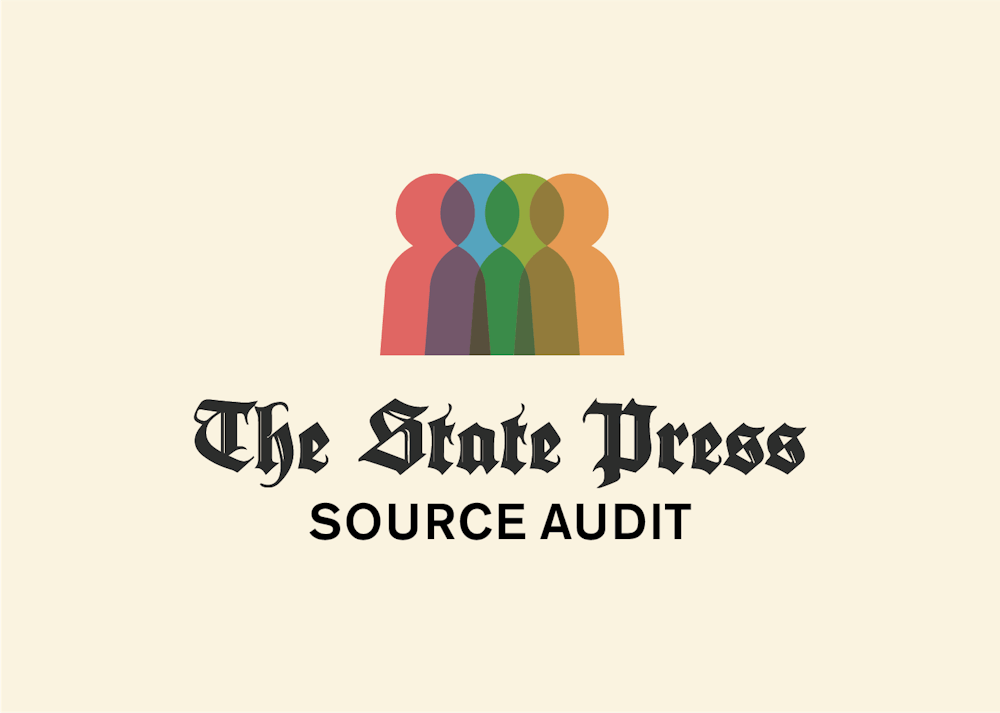The State Press is excited to share the results from its Fall 2021 source audit, our second source audit ever.
We collected the demographic information of 512 sources, all of whom spoke on a range of topics, such as LGBTQ+ student debt to COVID-19 on campus.
We implemented the source audit to our newsroom in Fall 2020 for two main reasons: to better understand the demographics of the people reporters were talking to and to be transparent about who those people were.
We instruct our reporters to ask each person they interview about their race, religion, gender, pronouns, age and occupation. Sources may decline to answer some or all of the questions, and all responses are reported anonymously.
To ensure the highest possible accuracy in our data collection, a student member of The State Press verifies the number of people quoted in each story published online with the number of source audit responses collected internally.
Every semester, we also ask our staff to fill out an anonymous demographics survey to understand the diversity of the people working in our newsroom. Over 58% of our staff responded identifying as only white, 13.33% responded identifying as only Asian, 6.7% as Hispanic and Latine and 1.7% for Black and Indigenous each.
For those who answered with multiple races, 18.3% of our staff responded with being Asian and at least one other race, 3.3% for both Black and Indigenous people and 1.7% each for both Middle Eastern/North African and Pacific Islander.
In our newsroom, 53.3% of the staff are women and 36.7% are men. Nonbinary staff members made up 8.3% of the staff, followed by 1.7% who identified as transgender.
Last semester, we published the results for the Spring 2021 source audit. To recap the results, nearly 55% of sources identified as white. A majority of our sources were women, at 52.3%, followed by men, at 44.6%. About half of our sources were students. The Spring 2021 source audit included 721 sources, about 200 more than the Fall 2021 audit, which reflects a decrease in stories published from spring to fall.
SPRING 2021 SOURCE AUDIT: What we found when we tracked our source demographics
To improve the accuracy of our data collection from the prior semester, we implemented more options in the religion and race sections to ensure more accurate representation and comprehensive data. We also added a "declined to answer" category to every graph.
Some of these changes included adding Pacific Islander and Hispanic when asking about race and ethnicity and adding Jainism and more specific Christian religion options, such as Catholic. In the occupation category, we provided more specific examples for our reporters on what each category entails. We also give the option for reporters to check off multiple races if a source identified as multiracial.
The percentages for each of the graphs shown below are rounded, so the graphs may not add up to 100%.
Race and Ethnicity
In continuation from the Spring 2021 source audit, we asked reporters to choose which race(s) their sources identified as. We added a multiracial option, but that option didn't provide specific details as to how the sources identified.
Here's the breakdown of how our sources identified: 53.71% were white, 11.13% were either Hispanic or Latine, 10.35% were Asian, 8.79% were Black/African American, 7.23% were multiracial, 2.54% were Middle Eastern/North African, 2.34% were Indigenous/Native American, 2.34% declined to answer, and 0.98% were Pacific Islanders.
The percentage of sources who said they were white, Latine or Hispanic, Asian, multiracial, or Middle Eastern/North African remained relatively the same compared to the Spring 2021 semester. The largest variance between Spring 2021 and Fall 2021 was for our Black/African American sources, which was a 1.91% decrease.
Moving forward for the Spring 2022 semester, we decided to remove the multiracial option to avoid any generalizations or vagueness and to ensure accuracy on the data for race.
Religion
This semester, we have data to look back on for our sources' religion. Based on responses from the Spring 2021 source audit, we added more choices, such as spiritual, agnostic and Jainism. We also separated the Christian section into Catholic and non-Catholic.
The number of sources who declined to answer made up nearly one-third of the responses at 32.23%.
Out of the sources who responded with a religious belief, Christian (non-Catholic) made up the largest percentage at 13.67%, followed by 12.5% who said they were atheists. Additionally, 10.55% of sources were agnostic, 9.57% were Christian (Catholic), 2.73% were Hindu, 1.76% were Muslim, and 1.37% were Jewish.
None of our sources identified as Jain or Sikh.
For the Spring 2022 semester, we did not make any changes to the religion section, but we are looking to compare the results from this semester with last semester to analyze the trends.
Gender
The percentage of women and men we sourced was 46.1% and 45.9% respectively. As a result, there was a decrease in women sourced this semester, dropping over 6% from last semester's data.
We included a nonbinary option for those who identify outside the gender binary; those people made up 4.7% of our sources.
Job Field
We defined University faculty, staff and administration as ASU affiliates, and anyone outside of the University was categorized in a different field, such as law or engineering.
Nearly half of our sources, 49.02%, were students, a slight decrease from 49.4% in the Spring 2021 semester.
University faculty followed students at 14.06%. University faculty included professors, who are tenure-track, lecturers and postdoctoral fellows.
University staff, who work for the university in a non-teaching capacity, accounted for 9.18% of our sources.
Age
Nearly half of the respondents said they were between 18-23 years old, and 11.91% of the respondents said they were between 31-40 years old.
Fairly consistent with the prior semester's data, over 80% our sources said they were 50 years old or younger.
Final Thoughts
We are constantly assessing which communities we need to better include in our stories to ensure all voices are represented and heard. Our outreach extends far beyond ASU, and there are no perfectly comparable data sets that represent our scope. But one area where we fell short was clear: Hispanic or Latine people made up approximately 22% of ASU's total student enrollment in Fall 2021 and around 30% of Arizona's population in 2020 but only 11.13% of our sources.
We will continue reminding our reporters to complete the source audit for their stories to further improve the accuracy of our sourcing.
To better serve our large and changing University audience, The State Press has increased its outreach efforts to various on-campus clubs, encouraging students to share their ideas, questions, comments and concerns.
We invite all students, faculty and staff to our next town hall on March 22 at 4:30 p.m. both on Zoom and in the Tempe Memorial Union. Come meet our editors, reporters and staffers to learn about our newsroom or tell us how we can better support your interests. Our editors can be found and reached using the information found on our masthead.
This semester, we also implemented monthly internal newsroom trainings to train our staff on how to accurately cover specific communities and events, such as protests. The planned trainings we have for this semester have included sessions on covering the disability community and more equitable reporting on Indigenous communities. Our next training will look to include more Hispanic and Latine voices.
As students ourselves, we want to ensure we're equipped with the knowledge and tools necessary for better coverage of our various communities on and off campus.
Reach the diversity officer for the Spring 2022 semester at anatar12@asu.edu or follow @AnushaNat1 on Twitter.
Like The State Press on Facebook and follow @statepress on Twitter.





